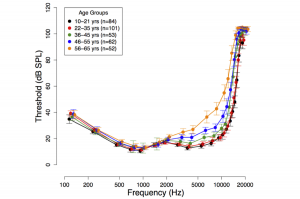
From before birth through every day of our lives, we count on our acute sense of hearing for life-critical functions. In this line of work we study the maturation and aging of hearing through the human lifespan. In particular we are interested in the changes in inner ear (cochlea) function. Over the last few years we have collaborated with developmental scientist Carolina Abdala (University of Southern California) to study the maturation of inner ear function in premature and term infants. In another collaboration with Northwestern colleague Jonathan Siegel, we have evaluated changes in inner ear function during middle age. While this major focus in our laboratory continues to reveal interesting new knowledge, we have already demonstrated remarkable changes in inner ear function much earlier in life than previously known. Our results seem to suggest that the human inner ear starts to show signs of age-related changes as early as the third decade of life and these changes accelerate in the next twenty years.
This work has profound implications on when and how to deliver hearing health care. These findings also shed new light on the timeline of auditory aging.
Search PubMed
